A Patent Bibliometric Analysis of Carbon Capture, Utilization, and Storage (CCUS) Technology
Abstract
:1. Introduction
2. Data and Methods
2.1. Data Source
2.2. Data Preprocessing
2.2.1. Patent Dates and Countries
2.2.2. Patentee Disambiguation
2.3. Tools and Software
3. Results
3.1. Overall Analysis
3.2. Geographical Analysis
3.3. Patentee Analysis
3.3.1. Patentee Statistics
3.3.2. Patent Disclosure Analysis
3.3.3. Patentee Cooperation Network Analysis
3.4. Content Analysis
3.4.1. Topic Analysis
3.4.2. Patent Topic Evolution Analysis
3.4.3. Topic Analysis of High-Value Patents
4. Discussion
5. Conclusions
Author Contributions
Funding
Institutional Review Board Statement
Informed Consent Statement
Data Availability Statement
Conflicts of Interest
References
- John, M. Environmental Sustainability: A Definition for Environmental Professionals. J. Environ. Sustain. 2011, 1, 2. [Google Scholar]
- Alsarhan, L.M.; Alayyar, A.S.; Alqahtani, N.B.; Khdary, N.H. Circular Carbon Economy (CCE): A Way to Invest CO2 and Protect the Environment, a Review. Sustainability 2021, 13, 11625. [Google Scholar] [CrossRef]
- Grunig, M.; Mazzi, D.; Calanca, P.; Karger, D.; Pellissier, L. Crop and forest pest metawebs shift increased linkage and suitability overlap under climate change. Commun. Biol. 2020, 3, 233. [Google Scholar] [CrossRef]
- Sabine, C.L.; Feely, R.A.; Gruber, N.; Key, R.M.; Lee, K.; Bullister, J.L.; Wanninkhof, R.; Wong, C.S.; Wallace, D.W.R.; Tilbrook, B. The oceanic sink for anthropogenic CO2. Science 2004, 305, 367–371. [Google Scholar] [CrossRef]
- Zhang, Y.; Chu, Z.; Song, D. Review of the Law Popularizing Education on Administrative Compulsion in Response to Major Epidemic Situations in China. Sustainability 2022, 14, 6853. [Google Scholar] [CrossRef]
- Climate Ambition Summit 2020. Available online: https://www.climateambitionsummit2020.org/index.php#watch (accessed on 2 February 2023).
- IEA. CCUs in Clean Energy Transitions; IEA: Paris, France, 2019. [Google Scholar]
- Bajpai, S.; Shreyash, N.; Singh, S.; Memon, A.R.; Sonker, M.; Tiwary, S.K.; Biswas, S. Opportunities, challenges and the way ahead for carbon capture, utilization and sequestration (CCUS) by the hydrocarbon industry: Towards a sustainable future. Energy Rep. 2022, 8, 15595–15616. [Google Scholar] [CrossRef]
- IEA. CCUS in the Transition to Net-Zero Emissions. Available online: https://www.iea.org/reports/ccus-in-clean-energy-transitions/ccus-in-the-transition-to-net-zero-emissions (accessed on 2 February 2023).
- Yang, Y.C.; Tao, H.S.; Yang, J.H.; Shang, Q.H.; Cao, S.G. Research on CO2 quality pipeline transportation based on Yanchang Oilfield CCUS. Matec Web Conf. 2017, 100, 02004. [Google Scholar] [CrossRef]
- Zhang, S.; Zhuang, Y.; Liu, L.L.; Zhang, L.; Du, J. Optimization-based approach for CO2 utilization in carbon capture, utilization and storage supply chain. Comput. Chem. Eng. 2020, 139, 106885. [Google Scholar] [CrossRef]
- Kim, I.; Yoo, Y.; Son, J.; Park, J.; Huh, I.S.; Kang, D. Two-step mineral carbonation using seawater-based industrial wastewater: An eco-friendly carbon capture, utilization, and storage process. J. Mater. Cycles Waste Manag. 2020, 22, 333–347. [Google Scholar] [CrossRef]
- Hussin, F.; Aroua, M.K. Recent trends in the development of adsorption technologies for carbon dioxide capture: A brief literature and patent reviews (2014–2018). J. Clean. Prod. 2020, 253, 119707. [Google Scholar] [CrossRef]
- Hanifa, M.; Agarwal, R.; Sharma, U.; Thapliyal, P.C.; Singh, L.P. A review on CO2 capture and sequestration in the construction industry: Emerging approaches and commercialised technologies. J. CO2 Util. 2023, 67, 102292. [Google Scholar] [CrossRef]
- Theeyattuparampil, V.V.; Vidican, G.; Al-Saleh, Y. Challenges and opportunities for the emerging carbon capture, utilisation and storage innovation system in the United Arab Emirates. Int. J. Innov. Learn. 2014, 13, 284–307. [Google Scholar] [CrossRef]
- Budzianowski, W.M. Implementing carbon capture, utilisation and storage in the circular economy. Int. J. Glob. Warm. 2017, 12, 272–296. [Google Scholar] [CrossRef]
- Zhang, Z.; Wang, T.; Blunt, M.J.; Anthony, E.J.; Park, A.H.A.; Hughes, R.W.; Webley, P.A.; Yan, J. Advances in research on carbon capture, utilization and storage. Appl. Energy 2020, 278, 115627. [Google Scholar] [CrossRef]
- Zhang, W.W.; Dai, C.Y.; Luo, X.M.; Ou, X.M. Policy incentives in carbon capture utilization and storage (CCUS) investment based on real options analysis. Clean Technol. Environ. Policy 2021, 23, 1311–1326. [Google Scholar] [CrossRef]
- Rong, J.; Peng, B.; Liu, Q.; Jia, J.H. Influence of carbon market on carbon capture, utilization and storage industrialization development. Thermal Power Generation 2021, 50, 43–46. [Google Scholar]
- Song, D.D.; Jiang, T.; Rao, C.P. Review of Policy Framework for the Development of Carbon Capture, Utilization and Storage in China. International. J. Environ. Res. Public Health 2022, 19, 16853. [Google Scholar] [CrossRef]
- Bae, J.; Chung, Y.; Lee, J.; Seo, H. Knowledge spillover efficiency of carbon capture, utilization, and storage technology: A comparison among countries. J. Clean. Prod. 2020, 246, 119003. [Google Scholar] [CrossRef]
- Jiang, K.; Ashworth, P. The development of Carbon Capture Utilization and Storage (CCUS) research in China: A bibliometric perspective. Renew. Sustain. Energy Rev. 2021, 138, 110521. [Google Scholar] [CrossRef]
- Tapia, J.F.D.; Lee, J.Y.; Ooi, R.E.; Foo, D.C.; Tan, R.R. A review of optimization and decision-making models for the planning of CO2 capture, utilization and storage (CCUS) systems. Sustain. Prod. Consum. 2018, 13, 1–15. [Google Scholar] [CrossRef]
- Osman, A.I.; Hefny, M.; Maksoud, M.I.A.A.; Elgarahy, A.M.; Rooney, D.W. Recent advances in carbon capture storage and utilisation technologies: A review. Environ. Chem. Lett. 2021, 19, 797–849. [Google Scholar] [CrossRef]
- Zhang, H.J.; Li, D.; Gu, X.; Chen, N. Three decades of topic evolution, hot spot mining and prospect in CCUS Studies based on CitNetExplorer. Chin. J. Popul. Resour. Environ. 2022, 20, 91–104. [Google Scholar] [CrossRef]
- Nawaz, M.; Suleman, H.; Maulud, A.S. Carbon Capture and Utilization: A Bibliometric Analysis from 2007–2021. Energies 2022, 15, 6611. [Google Scholar] [CrossRef]
- Zhang, Z.; Hu, G.W.; Mu, X.Z.; Kong, L. From low carbon to carbon neutrality: A bibliometric analysis of the status, evolution and development trend. J. Environ. Manag. 2022, 322, 116087. [Google Scholar] [CrossRef] [PubMed]
- Da Cruz, T.T.; Balestieri, J.A.P.; Silva, J.M.D.; Vilanova, M.R.N.; Oliveira, O.J.; Avila, I. Life cycle assessment of carbon capture and storage/utilization: From current state to future research directions and opportunities. Int. J. Greenh. Gas Control. 2021, 108, 103309. [Google Scholar] [CrossRef]
- Costa, L.P.D.M.; de Miranda, D.M.V.; de Oliveira, A.C.C.; Falcon, L.; Pimenta, M.S.S.; Bessa, I.G.; Wouters, S.J.; Alndrade, M.; Pinto, J. Capture and Reuse of Carbon Dioxide (CO2) for a Plastics Circular Economy: A Review. Processes 2021, 9, 759. [Google Scholar] [CrossRef]
- Maghzian, A.; Aslani, A.; Zahedi, R. Review on the direct air CO2 capture by microalgae: Bibliographic mapping. Energy Rep. 2022, 8, 3337–3349. [Google Scholar] [CrossRef]
- Zahedi, R.; Aslani, A.; Seraji, M.A.N.; Zolfaghari, Z. Advanced bibliometric analysis on the coupling of energetic dark greenhouse with natural gas combined cycle power plant for CO2 capture. Korean J. Chem. Eng. 2022, 39, 11. [Google Scholar] [CrossRef]
- Zolfaghari, Z.; Aslani, A.; Moshari, A.; Malekli, M. Direct air capture from demonstration to commercialization stage: A bibliometric analysis. Int. J. Energy Res. 2021, 46, 383–396. [Google Scholar] [CrossRef]
- Kang, J.N.; Wei, Y.M.; Liu, L.C.; Wang, J.W. Observing technology reserves of carbon capture and storage via patent data: Paving the way for carbon neutral. Technol. Forecast. Soc. Change 2021, 171, 120933. [Google Scholar] [CrossRef]
- Choi, H.; Woo, J. Investigating emerging hydrogen technology topics and comparing national level technological focus: Patent analysis using a structural topic model. Appl. Energy 2022, 313, 118898. [Google Scholar] [CrossRef]
- Kang, J.N.; Zhang, Y.L.; Chen, W.M. Delivering negative emissions innovation on the right track: A patent analysis. Renew. Sustain. Energy Rev. 2022, 158, 112169. [Google Scholar] [CrossRef]
- Miguez, J.L.; Porteiro, J.; Perez-Orozco, R.; Patino, D.; Rodriguez, S. Evolution of CO2 capture technology between 2007 and 2017 through the study of patent activity. Appl. Energy 2018, 211, 1282–1296. [Google Scholar] [CrossRef]
- Malekli, M.; Aslani, A.; Zolfaghari, Z.; Zahedi, R.; Moshari, A. Advanced bibliometric analysis on the development of natural gas combined cycle power plant with CO2 capture and storage technology. Sustain. Energy Technol. Assess. 2022, 52, 102339. [Google Scholar] [CrossRef]
- Cardoso, L.O.; Procópio, D.P.; Borrego, B.B.; Gracioso, L.H.; Stevani, C.V.; Freire, R.S.; do Nascimento, C.A.; Perpetuo, E.A. Overview of CO2 Bioconversion into Third-Generation (3G) Bioethanol-a Patent-Based Scenario. BioEnergy Res. 2022. [Google Scholar] [CrossRef]
- Severo, I.A.; dos Santos, A.M.; Depra, M.C.; Barin, J.S.; Jacob-Lopes, E. Microalgae photobioreactors integrated into combustion processes: A patent-based analysis to map technological trends. Algal Res. Biomass Biofuels Bioprod. 2021, 60, 102529. [Google Scholar] [CrossRef]
- Sharifzadeh, M.; Triulzi, G.; Magee, C.L. Quantification of technological progress in greenhouse gas (GHG) capture and mitigation using patent data. Energy Environ. Sci. 2019, 12, 2789–2805. [Google Scholar] [CrossRef]
- Miguez, J.L.; Porteiro, J.; Perez-Orozco, R.; Patino, D.; Gomez, M.A. Biological systems for CCS: Patent review as a criterion for technological development. Appl. Energy 2020, 257, 114032. [Google Scholar] [CrossRef]
- Yang, X.; Yu, X. Preventing Patent Risks in Artificial Intelligence Industry for Sustainable Development: A Multi-Level Network Analysis. Sustainability 2020, 12, 8667. [Google Scholar] [CrossRef]
- Zhang, G.Y.; Tang, C.Y.; Qi, Y. Alliance Network Diversity and Innovation Ambidexterity: The Differential Roles of Industrial Diversity, Geographical Diversity, and Functional Diversity. Sustainability 2020, 12, 1041. [Google Scholar] [CrossRef]
- Jin, L.L.; Sun, X.Z.; Ren, H.Q.; Huang, H. Hotspots and trends of biological water treatment based on bibliometric review and patents analysis. J. Environ. Sci. 2023, 125, 774–785. [Google Scholar] [CrossRef] [PubMed]
- Ye, Q.; Umer, Q.; Zhou, R.T.; Asmi, A.; Asmi, F. How publications and patents are contributing to the development of municipal solid waste management: Viewing the UN Sustainable Development Goals as ground zero. J. Environ. Manag. 2022, 325, 116496. [Google Scholar] [CrossRef]
- Pan, X.; Xiao, Z.T.; Guo, X.; Chen, Y. Research on foreign anti-terrorism intelligence early warning based on visual measurement. Adv. Intell. Syst. Comput. 2021, 12, 326–337. [Google Scholar]
- Dong, Y.Q.; Dong, Z.J. Bibliometric Analysis of Game Theory on Energy and Natural Resource. Sustainability 2023, 15, 1278. [Google Scholar] [CrossRef]
- Yang, K.H.; Ai, C.T. Visualising the Knowledge Domain of Reverse Logistics and Sustainability Performance: Scientometric Mapping Based on VOSviewer and CiteSpace. Sustainability 2023, 15, 1105. [Google Scholar] [CrossRef]
- Zema, T.; Sulich, A.; Grzesiak, S. Charging Stations and Electromobility Development: A Cross-Country Comparative Analysis. Energies 2023, 16, 32. [Google Scholar] [CrossRef]
- Sulich, A.; Sołoducho-Pelc, L. Changes in Energy Sector Strategies: A Literature Review. Energies 2022, 15, 7068. [Google Scholar] [CrossRef]
- Van Eck, N.J.; Waltman, L. Software survey: VOSviewer, a computer program for bibliometric mapping. Scientometrics 2010, 84, 523–538. [Google Scholar] [CrossRef]
- Ziegler, C.; Sinigaglia, T.; Martins, M.E.S.; Souza, A.M. Technological Advances to Reduce Apis mellifera Mortality: A Bibliometric Analysis. Sustainability 2021, 13, 8305. [Google Scholar] [CrossRef]
- Marion, T.; Welborn, M.; Della Porta, A.; Schoch, J.; Konda, S. Publication Productivity Using H-Index to Evaluate Academic Success Among Fellowship-Trained Mohs Surgeons. Dermatol. Surg. 2022, 49, 25–28. [Google Scholar] [CrossRef]
- Jones, B.M.; Rowley, J.P.; Sindhu, K.K.; Lehrer, E.J.; Hsieh, K.; Nehlsen, A.D.; Green, S.; Goodman, K.A. Gender Differences in the Research Productivity of Radiation Oncology Resident Graduates in the United States: 2015 to 2019. Adv. Radiat. Oncol. 2023, 8, 101135. [Google Scholar] [CrossRef] [PubMed]
- Changsha Zichen Technology Development Corporation Website. Available online: http://cszckj.com.cn/intro/1.html (accessed on 2 February 2023).
- Pittel, B.; Spencer, J.; Wormald, N. Sudden emergence of a giant k-core in a random graph. J. Comb. Theory Ser. B 1996, 67, 111–151. [Google Scholar] [CrossRef]
- Zhao, Q.; Shen, X.L.; Kun, D. Comparative analysis on technologies between Chinese and American large-sized oil companies based on patentometrics. J. Scientometr. Res. 2014, 3, 68–74. [Google Scholar]
- Wang, X.W.; Xu, S.M.; Peng, L.; Hu, Z.G. Structural Analysis of Technology Network Based on Patent Co-classification Analysis: 1971–2010. J. China Soc. Sci. Tech. Inf. 2013, 32, 198–205. [Google Scholar]
- Alves, M.; Grignard, B.; Mereau, R.; Jerome, C.; Tassaing, T.; Detrembleur, C. Organocatalyzed coupling of carbon dioxide with epoxides for the synthesis of cyclic carbonates: Catalyst design and mechanistic studies. Catal. Sci. Technol. 2017, 7, 2651–2684. [Google Scholar] [CrossRef]
- Lan, D.H.; Fan, N.; Wang, Y.; Gao, X.; Zhang, P. Recent advances in metal-free catalysts for the synthesis of cyclic carbonates from CO2 and epoxides. Chin. J. Catal. 2016, 37, 826–845. [Google Scholar] [CrossRef]
- Liu, H.L.; Zhu, Y.T.; Ma, J.M.; Zhang, Z.C.; Hu, W.P. Recent advances in atomic-level engineering of nanostructured catalysts for electrochemical CO2 reduction. Adv. Funct. Mater. 2020, 30, 1910534. [Google Scholar] [CrossRef]
- Liu, Y.; Chen, Y.; Gao, Z.R.; Zhang, X.; Zhang, L.J.; Wang, M.; Chen, B.; Diao, Y.; Li, Y.; Xiao, D.; et al. Embedding high loading and uniform Ni nanoparticles into silicalite-1 zeolite for dry reforming of methane. Appl. Catal. B Environ. 2022, 307, 121202. [Google Scholar] [CrossRef]
- Niazi, M.; Hussain, A. Agent-based computing from multi-agent systems to agent-based models: A visual survey. Scientometrics 2011, 89, 479–499. [Google Scholar] [CrossRef]
- Bicheng, D.; Adnan, N.; Harji, M.B.; Ravindran, L. Evolution and hotspots of peer instruction: A visualized analysis using CiteSpace. Educ. Inf. Technol. 2022. [Google Scholar] [CrossRef]
- Jin, Y.L.; Xu, Y.; Li, R.; Zhao, C.; Yuan, Z.H. Comprehensive Evaluation of China’s Input–Output Sector Status Based on the Entropy Weight-Social Network Analysis Method. Sustainability 2022, 14, 14588. [Google Scholar] [CrossRef]
- Liu, H.L.; Zhu, C.X.; Cao, X.; Hsu, Y. The Sustainability Evaluation of Masks Based on the Integrated Rank Sum Ratio and Entropy Weight Method. Sustainability 2022, 14, 5706. [Google Scholar] [CrossRef]
- Gao, Y.X.; Dong, X.F.; Han, F.; Li, Z.Y. An Optimization Model for a Desert Railway Route Scheme Based on Interval Number and TOPSIS. Appl. Sci. 2022, 12, 10728. [Google Scholar] [CrossRef]
- Fan, R.L.; Zhang, H.L.; Gao, Y. The global cooperation in asteroid mining based on AHP, entropy and TOPSIS. Appl. Math. Comput. 2023, 437, 127535. [Google Scholar] [CrossRef]
- Liu, G.Z.; Cai, B.F.; Li, Q.; Zhang, X.; Ouyang, T. China’s pathways of CO2 capture, utilization and storage under carbon neutrality vision 2060. Carbon Manag. 2022, 13, 435–449. [Google Scholar] [CrossRef]
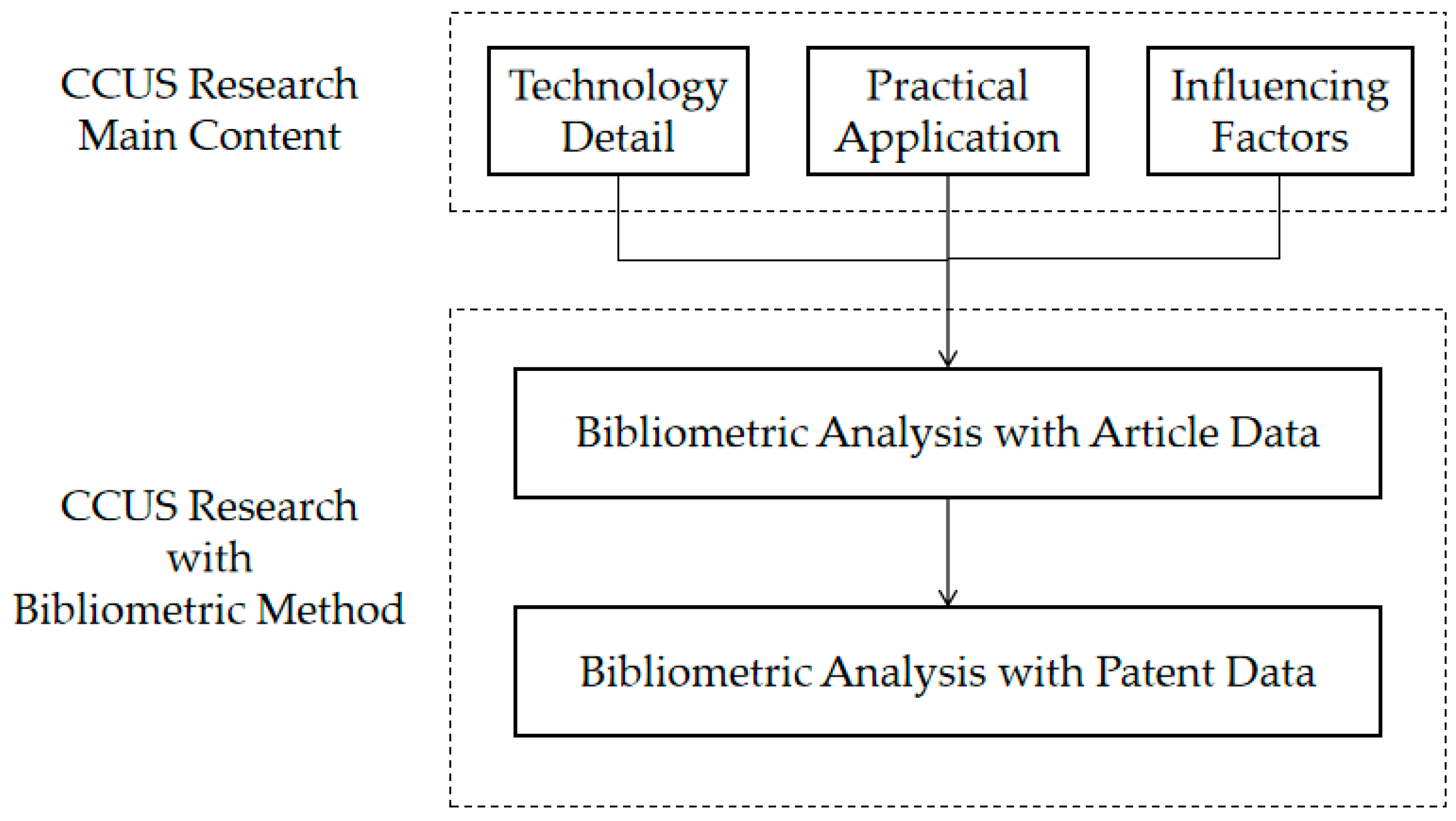
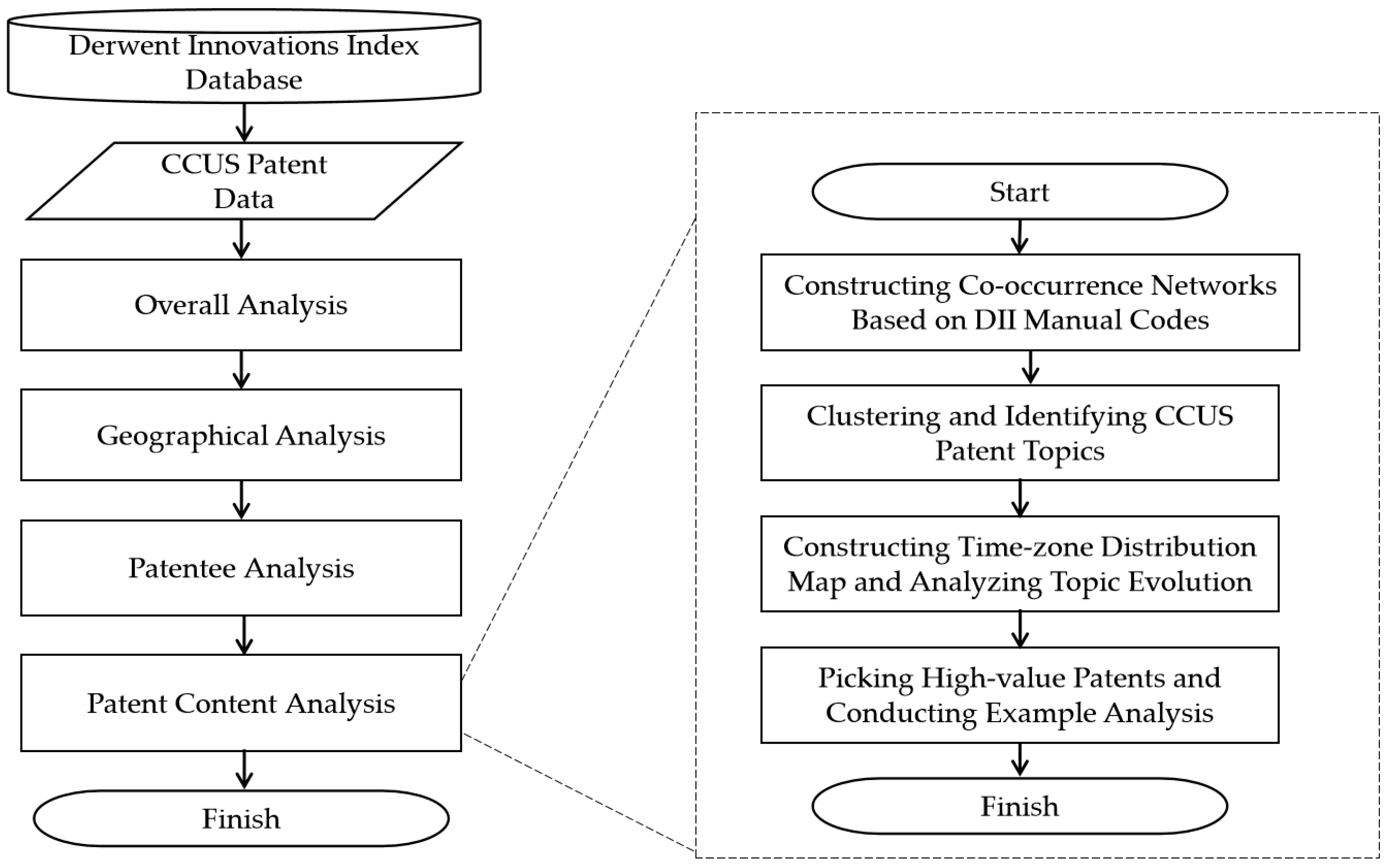
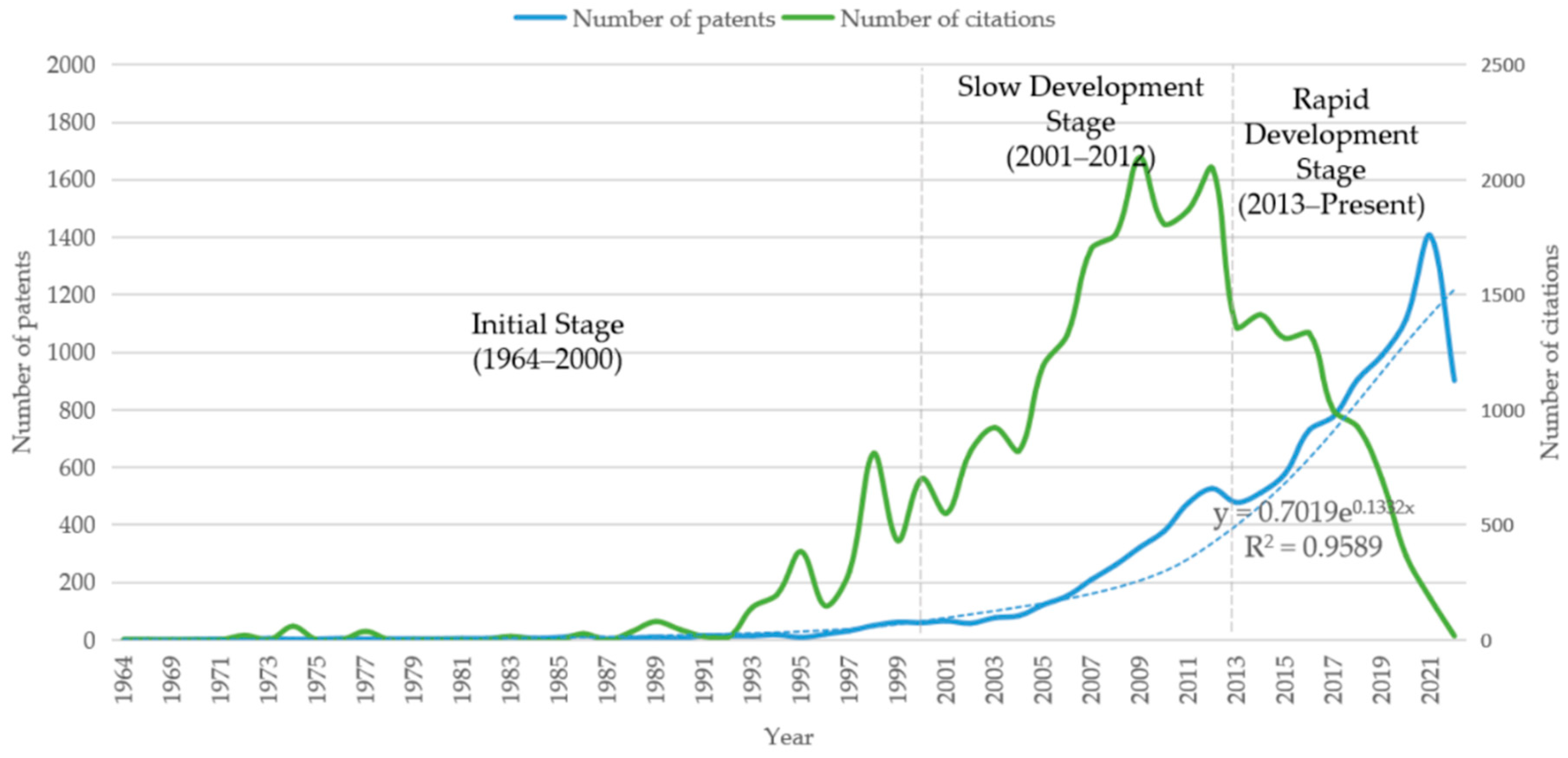
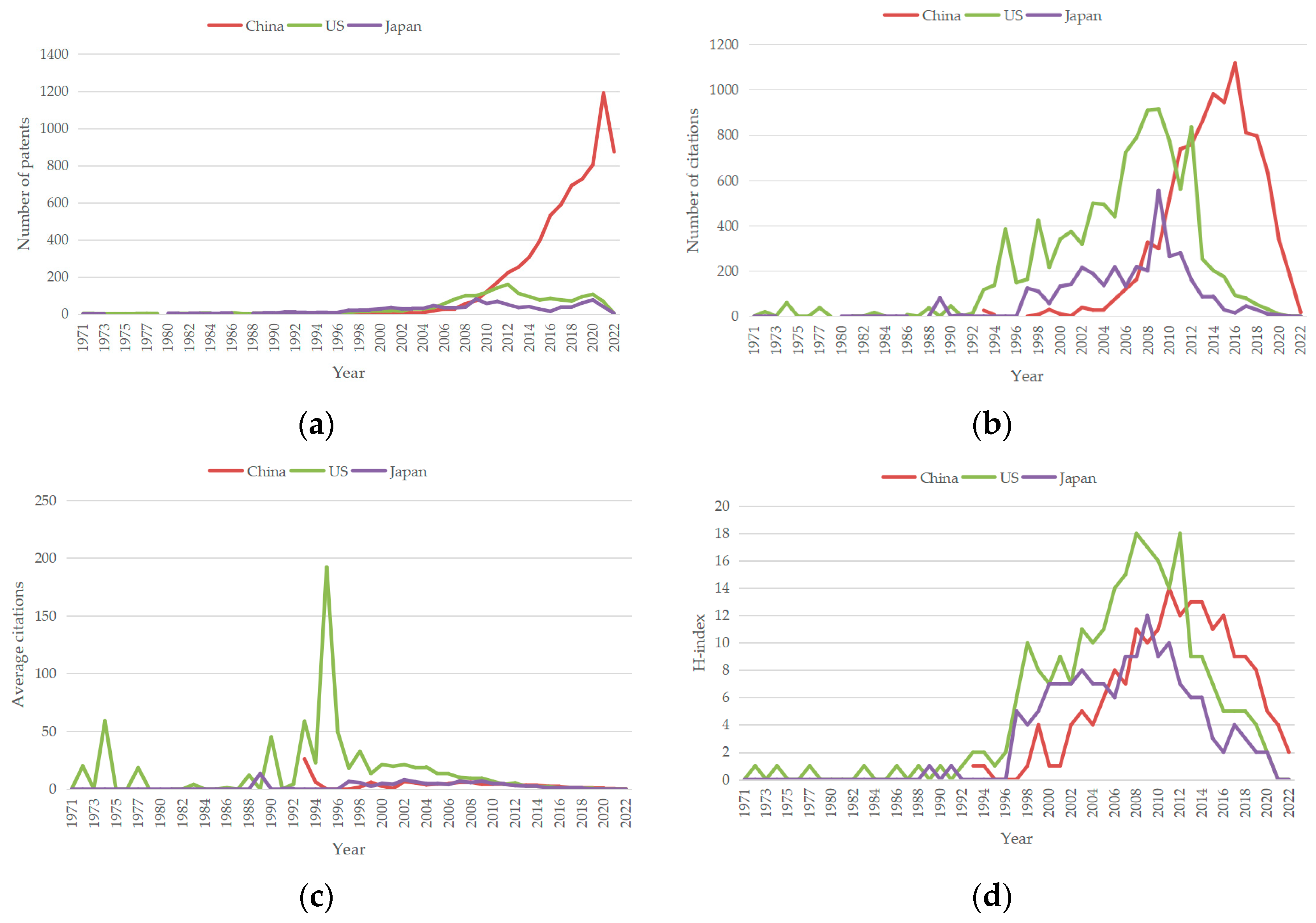
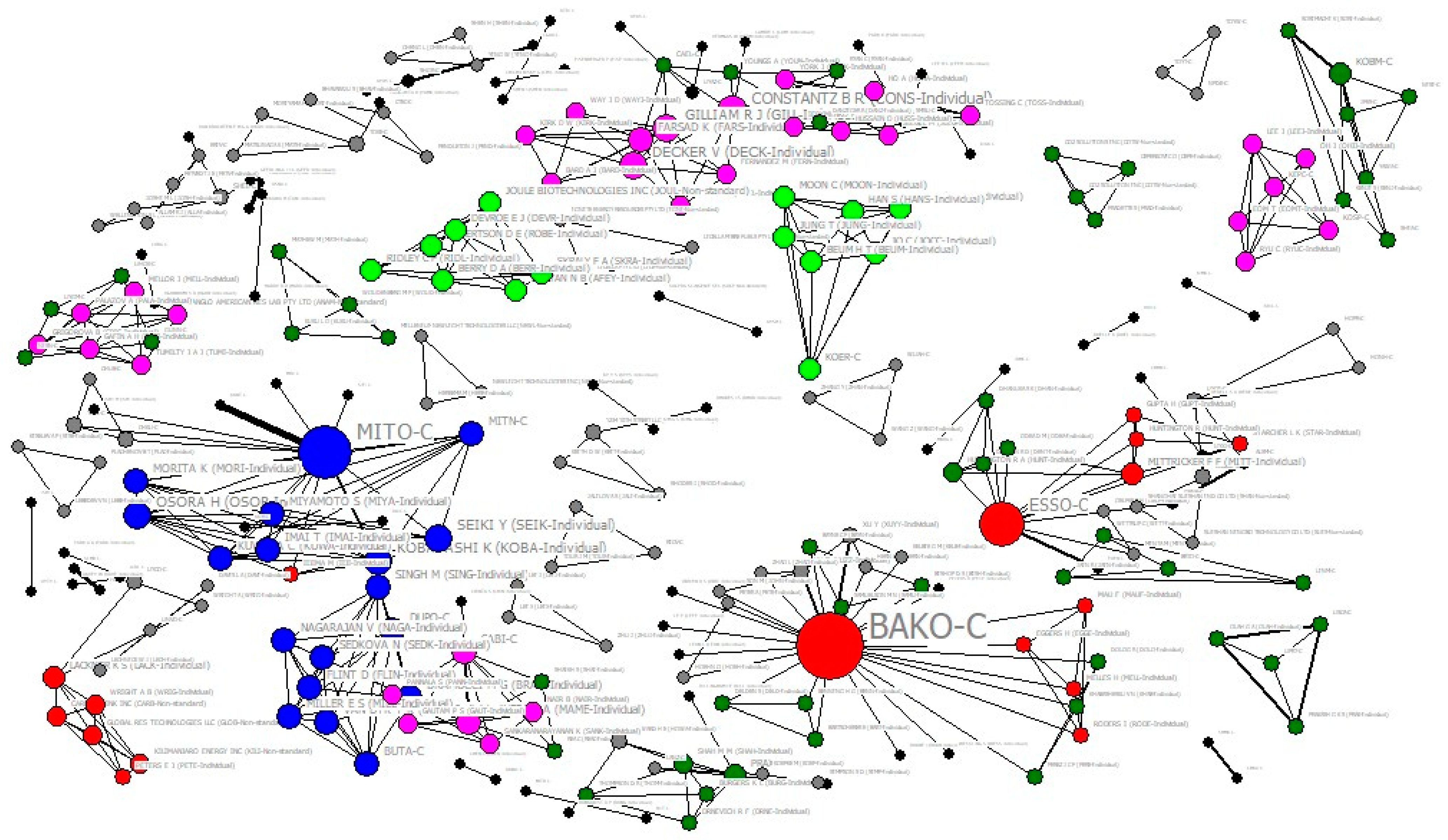
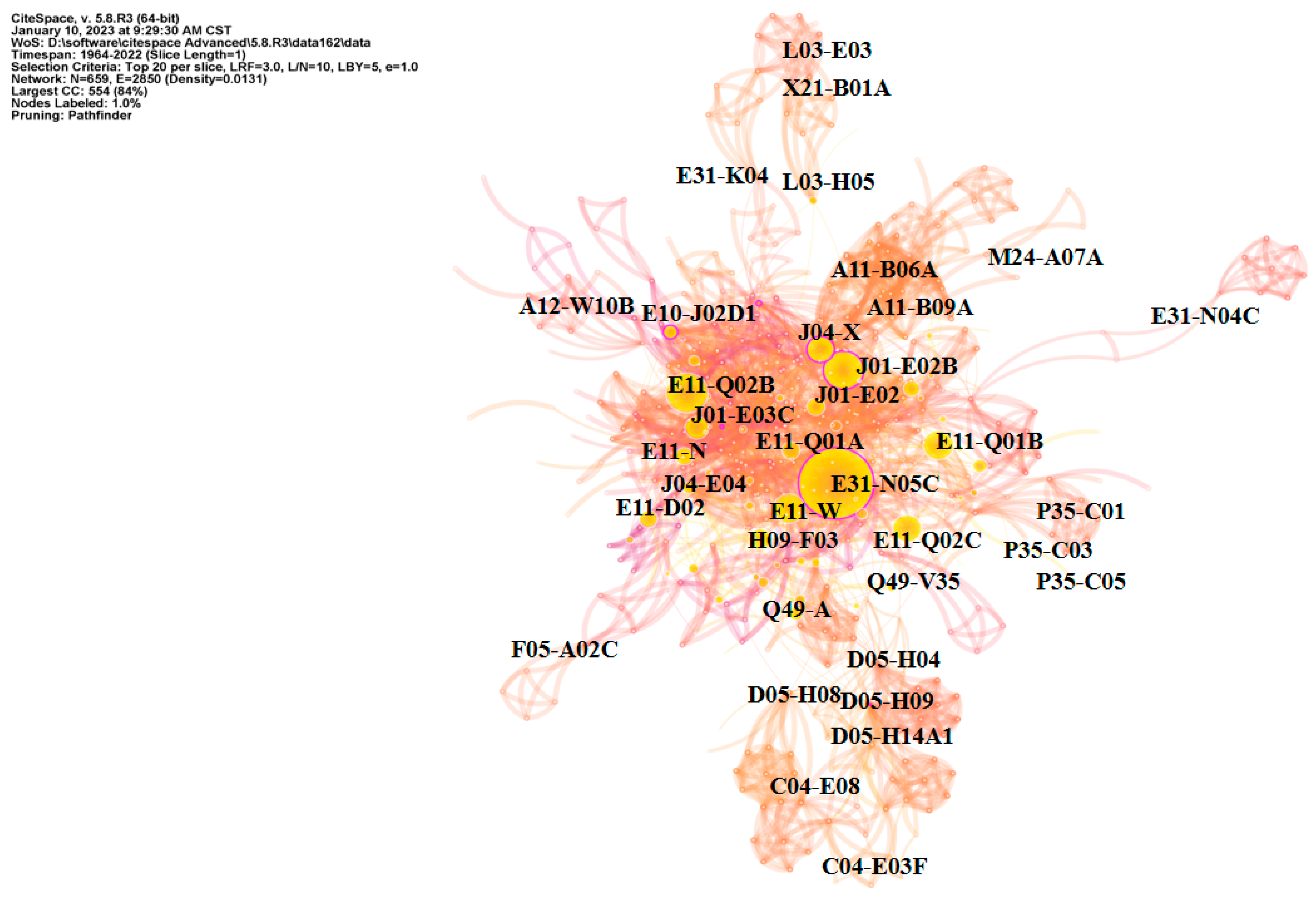
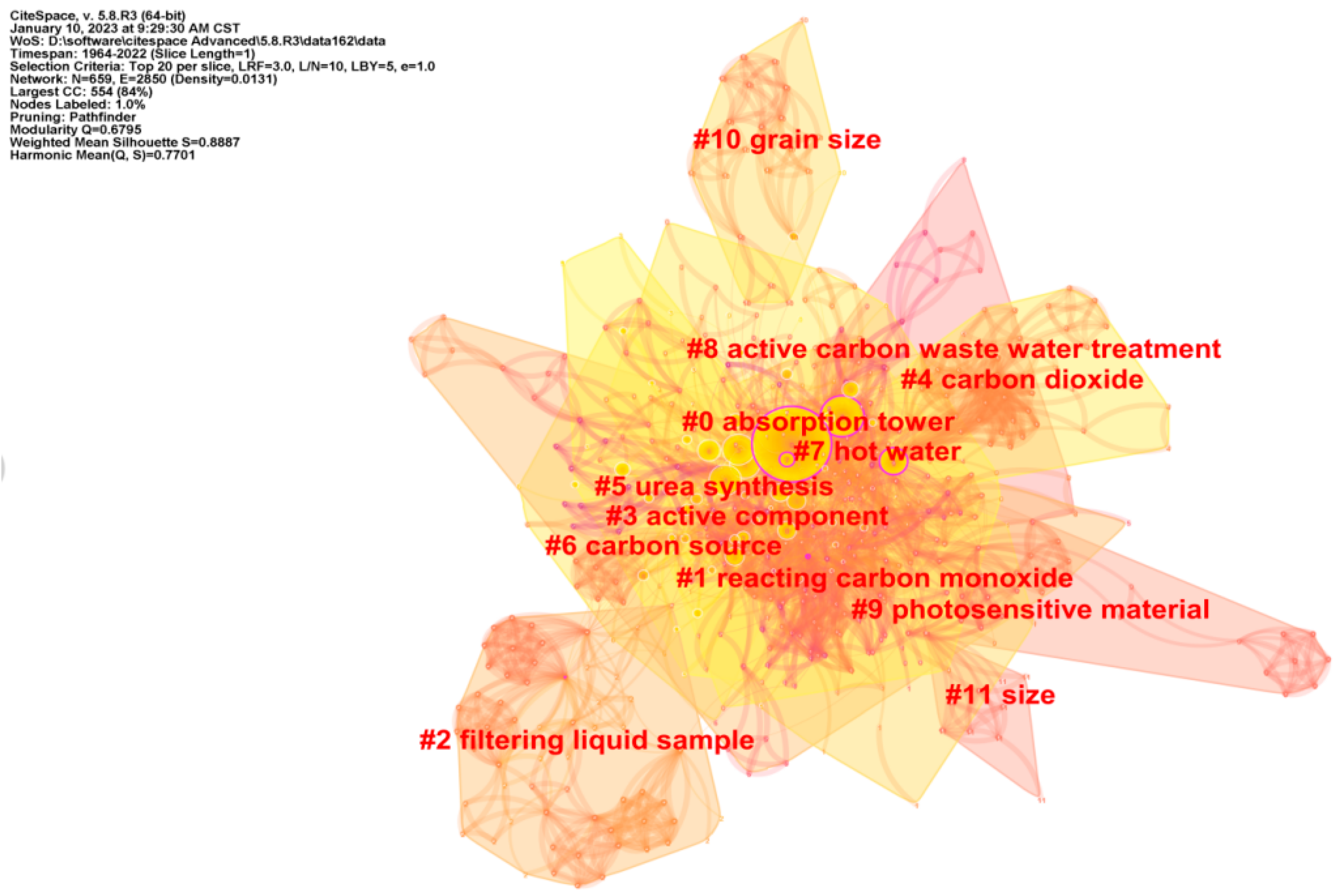
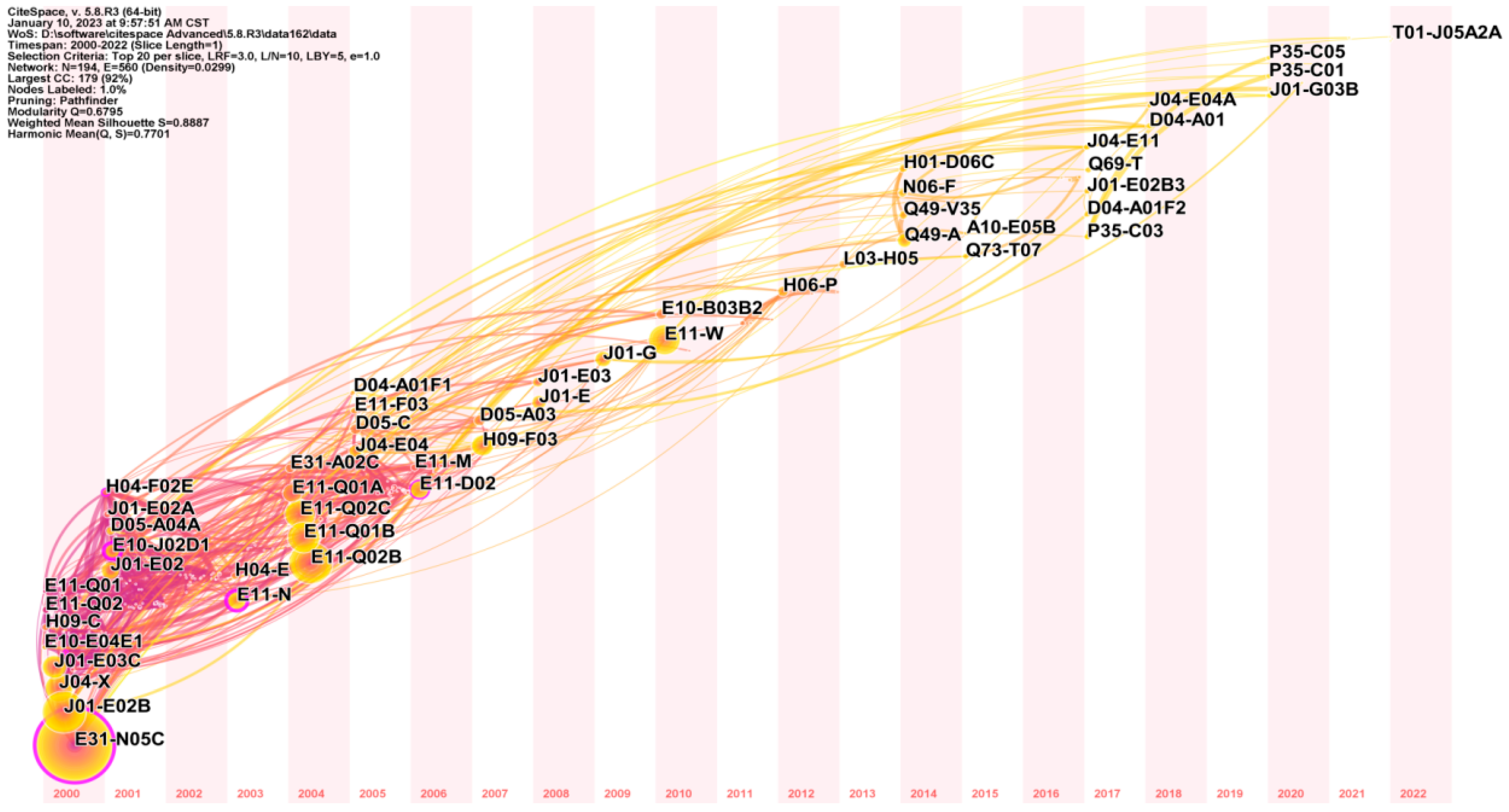
| Countries | TA (%) | TC | AC | H | AYS |
|---|---|---|---|---|---|
| China | 7102 (61.56%) | 9852 | 1.39 | 22 | 1993 |
| USA | 1739 (15.08%) | 10685 | 6.14 | 49 | 1971 |
| Japan | 1056 (9.15%) | 3523 | 3.34 | 25 | 1971 |
| South Korea | 562 (4.87%) | 776 | 1.38 | 12 | 1986 |
| EPO | 173 (1.50%) | 1025 | 5.92 | 16 | 1999 |
| Germany | 125 (1.08%) | 619 | 4.95 | 1 | 1964 |
| India | 123 (1.07%) | 46 | 0.37 | 4 | 1999 |
| UK | 123 (1.07%) | 452 | 3.67 | 12 | 1975 |
| Australia | 85 (0.74%) | 464 | 5.46 | 10 | 2001 |
| France | 61 (0.53%) | 410 | 6.72 | 10 | 1984 |
| Patentee | Patentee Name | Country | TA (%) | TC | AC | H | AYS |
|---|---|---|---|---|---|---|---|
| MITO-C | Mitsubishi Group | Japan | 164 (1.08%) | 1191 | 7.26 | 17 | 1982 |
| BAKO-C | Baker Hughes INTEQ | USA | 160 (1.05%) | 372 | 2.33 | 10 | 2008 |
| CHHN-C | China Huaneng Group | China | 120 (0.79%) | 132 | 1.10 | 7 | 2012 |
| SNPC-C | China Petroleum and Chemical Corporation | China | 105 (0.69%) | 167 | 1.59 | 7 | 1999 |
| TOKE-C | Toshiba Corporation | Japan | 75 (0.49%) | 381 | 5.08 | 12 | 1980 |
| SGCC-C | State Grid Corporation of China | China | 64 (0.42%) | 69 | 1.08 | 5 | 2014 |
| ESSO-C | Exxon Corporation | USA | 57 (0.37%) | 342 | 6.00 | 10 | 1983 |
| UYXJ-C | Xi’an Jiaotong University | China | 53 (0.35%) | 91 | 1.72 | 6 | 2011 |
| ISHI-C | Ishikawajima-Harima Heavy Industries | Japan | 50 (0.33%) | 233 | 4.66 | 8 | 1989 |
| UYZH-C | Zhejiang University | China | 50 (0.33%) | 85 | 1.70 | 5 | 2007 |
| KANT-C | Kansai Electric Power Company | Japan | 49 (0.32%) | 589 | 12.02 | 14 | 1991 |
| GENE-C | General Electric Company | USA | 46 (0.30%) | 263 | 5.72 | 7 | 2005 |
| UYSE-C | Southeast University | China | 45 (0.30%) | 173 | 3.84 | 7 | 2007 |
| HITA-C | Hitachi Limited | Japan | 42 (0.28%) | 108 | 2.57 | 7 | 1986 |
| SAOI-C | Saudi Arabian Oil Company | Kingdom of Saudi Arabia | 41 (0.27%) | 350 | 8.54 | 11 | 2005 |
| CHAN-Nonstandard | Changsha Zichen Technology Development Co., Ltd. | China | 38 (0.25%) | 37 | 0.97 | 4 | 2017 |
| UYMB-C | China University of Mining and Technology | China | 38 (0.25%) | 32 | 0.84 | 4 | 2010 |
| CNPC-C | China National Petroleum Corporation | China | 36 (0.24%) | 47 | 1.31 | 4 | 2010 |
| UYQI-C | Tsinghua University | China | 36 (0.24%) | 107 | 2.97 | 7 | 2005 |
| KOER-C | Korea Energy Research Institute | Republic of Korea | 35 (0.23%) | 55 | 1.57 | 5 | 2004 |
| Patentee | Patentee Name | Disclosure Country and Region | TD | TC | AC | DYS |
|---|---|---|---|---|---|---|
| MITO-C | Mitsubishi Group | Japan | 148 | 1169 | 7.90 | 1990 |
| USA | 114 | 1074 | 9.42 | 1994 | ||
| EPO | 103 | 1052 | 10.21 | 1989 | ||
| Canada | 89 | 790 | 8.88 | 1993 | ||
| WIPO | 88 | 292 | 3.32 | 2003 | ||
| Australia | 87 | 720 | 8.28 | 1993 | ||
| Russia | 33 | 425 | 12.88 | 2004 | ||
| USA | 159 | 368 | 2.31 | 2009 | ||
| BAKO-C | Baker Hughes INTEQ | WIPO | 110 | 308 | 2.80 | 2009 |
| UK | 46 | 131 | 2.85 | 2012 | ||
| Brazil | 45 | 88 | 1.96 | 2016 | ||
| Norway | 45 | 128 | 2.84 | 2012 | ||
| Canada | 40 | 174 | 4.35 | 2011 | ||
| CHHN-C | China Huaneng Group | China | 120 | 132 | 1.10 | 2013 |
| WIPO | 2 | 2 | 1.00 | 2021 | ||
| SNPC-C | China Petroleum and Chemical Corporation | China | 105 | 167 | 1.59 | 2001 |
| WIPO | 2 | 17 | 8.50 | 2010 | ||
| USA | 2 | 15 | 7.50 | 2012 | ||
| TOKE-C | Toshiba Corporation | Japan | 74 | 381 | 5.15 | 1982 |
| USA | 30 | 202 | 6.73 | 1984 | ||
| China | 19 | 107 | 5.63 | 2011 | ||
| Australia | 17 | 112 | 6.59 | 2010 | ||
| EPO | 16 | 138 | 8.63 | 1998 |
| DII Manual Code | Count | Centrality | Counts Rank | Centrality Rank | Translation |
|---|---|---|---|---|---|
| E31-N05C | 1853 | 0.13 | 1 | 4 | Carbon dioxide |
| J01-E02B | 950 | 0.11 | 2 | 6 | Treatment of exhaust gases with solid adsorbents |
| J04-X | 301 | 0.18 | 7 | 1 | Plasma processes, Langmuir–Brogit processes, noncatalytic chemistry, miniaturized reactors, gas generators, and other chemical methods |
| E11-N | 242 | 0.1 | 8 | 8 | Electrochemical processes and apparatus |
| E10-J02D1 | 128 | 0.14 | 16 | 2 | Methane |
| J01-E02 | 229 | 0.09 | 11 | 9 | Treatment of exhaust gases (general) |
| E11-Q01 | 91 | 0.13 | 23 | 5 | Separation, extraction, recovery, purification processes and apparatus |
| E11-Q01B | 604 | 0.03 | 4 | 29 | Decontamination by physical means |
| D05-A04A | 98 | 0.05 | 19 | 15 | Fermentation of organic waste, municipal waste or sludge |
| L03-H05 | 79 | 0.05 | 25 | 16 | Vehicle related |
| E11-Q02 | 76 | 0.08 | 30 | 11 | Removal, wastewater treatment processes and apparatus |
| J01-E03 | 77 | 0.05 | 28 | 17 | Gas separation (general) |
| Cluster ID | Size | Silhouette | Top Terms (LLR) |
|---|---|---|---|
| #0 | 99 | 0.76 | Absorption tower; recovering carbon dioxide; regeneration tower; waste gas; carbon dioxide recovery apparatus |
| #1 | 85 | 0.822 | Reacting carbon monoxide; fuel cell; using catalyst containing; air line; catalyst composition |
| #2 | 60 | 0.961 | Filtering liquid sample; color-forming reaction; detecting bacteria; Gram-negative bacteria; growth rate |
| #3 | 56 | 0.885 | Absorption tower; active component; recovering carbon dioxide; regeneration tower; cabinet body |
| #4 | 50 | 0.957 | Carbon dioxide; first channel; supporting column; active carbon; side wall |
| #5 | 47 | 0.952 | Urea synthesis; deionized water; weak exchanger; gas channel; diesel exhaust gas |
| #6 | 39 | 0.888 | Carbon dioxide; carbon source; producing biofuel; or oil; composite liquid fuel |
| #7 | 35 | 0.936 | Hot water; carbon dioxide; rubber MFR; cyclone storage hopper; returning carbon |
| #8 | 26 | 0.957 | Active carbon wastewater treatment; overflow pipe; catalytic conversion; technical hydrogen; two-phase separation |
| #9 | 24 | 0.926 | Photosensitive material; charge-generating layer containing; carbon transporting layer containing; carbon transport layer containing; amorphous silicon |
| #10 | 23 | 0.994 | Carbon dioxide; grain size; electrolyte sec; foamed metal; carbon powder |
| #11 | 10 | 0.995 | Size; selective gel; subterranean formation; permeability profile control; using combination |
| Year | DII Manual Code | Translation |
|---|---|---|
| 2000 | E31-N05C; J01-E02B; J04-X; J01-E03C; E10-E04E1; H09-C; E11-Q02; E11-Q01 | Carbon dioxide; treatment/separation of gases by solid sorbents; production of gases such as methanol; wastewater treatment; separation extraction recovery purification processes and equipment |
| 2001 | J01-E02; E10-J02D1; D05-A04A; J01-E02A; H04-F02E; D05-H02 | Methane; organic waste; sludge fermentation; culture media; waste gas treatment by wet process; preparation of catalysts for petroleum processes. |
| 2003 | E11-N; H04-E | Electrochemical processes and equipment; other petroleum processes |
| 2004 | E11-Q02B; E11-Q01B; E11-Q02C; E11-Q01A; E31-A02C | Industrial wastewater treatment; physical purification; chemical purification |
| 2005 | J04-E04; D05-C; E11-F03; D04-A01F1 | Catalysts; preparation of chemicals by fermentation; alkylation; arylation; carbon atom acylation; carbon chain condensation, extension and reforming |
| 2006 | E11-D02; E11-M | Hydrogenation; fermentation process and equipment |
| 2007 | H09-F03; D05-A03 | Municipal and agricultural waste treatment; fermentation plants |
| 2008 | J01-E; J01-E03 | Gas separation and treatment |
| 2009 | J01-G | Separation of dispersed particles from gases and vapors |
| 2010 | E10-B03B2; N07-J | Amino alcohols; catalysts for reactions of inorganic products |
| 2012 | H06-P | Fuel preparation |
| 2013 | L03-H05 | Carriers |
| 2014 | Q49-A; Q49-V35; N06-F | Mining and quarrying equipment; fluids, slurries; catalyst support |
| 2015 | Q73-T07; A10-E05B | Treatment and removal of combustion products; chemical modification by carbonization |
| 2017 | P35-C03; D04-A01F2; J01-E02B3; Q69-T; J04-E11 | Nozzles, hoses, pumps and delivery systems; activated carbon handling; activated carbon; structural details and accessories for gas/liquid tanks; catalyst production |
| 2018 | D04-A01; J04-E04A | Water purification; redox catalyst |
| 2020 | J01-G03B; P35-C01; P35-C05 | Regeneration/cleaning of filters specifically designed for exhaust gases; fire suppression equipment and methods; fire protection equipment and methods |
| 2022 | T01-J05A2A | Business model |
| Representative Patent Number | Priority Country | Patentee Name | Year | TC | RP | RNP | DC | SF | Patent Topic | CCUS Component |
|---|---|---|---|---|---|---|---|---|---|---|
| US2014260310-A1 | USA | Exxon Corporation | 2013 | 13 | 424 | 116 | 1 | 208 | Molten carbonate fuel cell | Carbon capture/utilization |
| US2012276356-A1 | USA | Baker Hughes INTEQ | 2011 | 36 | 693 | 444 | 4 | 18 | Composite downhole article | Carbon storage |
| US2013300066-A1 | USA | Baker Hughes INTEQ | 2012 | 29 | 738 | 424 | 11 | 18 | Metallic seal | Carbon storage |
| US2009294366-A1 | USA | Global Resource Technologies | 2005 | 86 | 616 | 306 | 11 | 27 | Carbon dioxide sorbent | Carbon capture |
| US2013047784-A1 | USA | Baker Hughes INTEQ | 2011 | 6 | 698 | 361 | 10 | 15 | Powder metal compact | Carbon storage |
| US2014134736-A1 | USA | University of California Regents | 2011 | 13 | 25 | 439 | 6 | 17 | Biological compound sulfate-reducing system | Carbon storage |
| US2011296872-A1 | USA | Eisenberger P. | 2010 | 56 | 688 | 189 | 7 | 42 | CO2 capture structure | Carbon capture |
| NZ560757-A | New Zealand | LanzaTech New Zealand Limited | 2007 | 65 | 464 | 173 | 4 | 68 | Carbon capture bioreactor | Carbon capture |
| WO2017197167-A1 | USA | William Marsh Rice University | 2016 | 9 | 1 | 424 | 15 | 1 | CO2 reduction equipment | Carbon utilization |
| WO2013034750-A2 | UK | Imperial Innovations Limited | 2011 | 27 | 27 | 361 | 49 | 37 | Synthetic method of polycarbonate | Carbon utilization |
| US2009200032-A1 | USA | Foret Plasma Labs LLC | 2007 | 26 | 580 | 211 | 3 | 46 | Fossil fuel recovery device | Carbon storage/utilization |
| US2009232861-A1 | USA | Global Resource Technologies | 2008 | 11 | 531 | 303 | 10 | 13 | Method of removing CO2 from fluid | Carbon capture |
| WO2006074945-A2 | Greece | Alkmy LTD | 2005 | 16 | 388 | 315 | 1 | 12 | Production method of concrete aggregate | Carbon utilization |
| US2010068109-A1 | USA | Comrie D.C. | 2006 | 87 | 463 | 101 | 13 | 46 | Method of removing CO2 from fluid | Carbon capture |
| US2017043333-A1 | USA | Carbon Sink LLC | 2006 | 2 | 435 | 297 | 4 | 2 | Materials that capture carbon dioxide from the ambient air | Carbon capture |
| AU2006303828-A1 | Australia | Calix Ltd | 2005 | 28 | 154 | 317 | 3 | 15 | Calcination/ carbonization cycle treatment system | Carbon capture/utilization |
| US2012304858-A1 | USA | Global Resource Technologies | 2007 | 39 | 385 | 262 | 8 | 19 | Method of removing CO2 from fluid | Carbon capture |
| US6148602-A | USA | Northern Resources Energy Corporation | 1998 | 179 | 18 | 1 | 2 | 4 | Carbon dioxide waste gas separation device | Carbon capture |
| US2010063902-A1 | USA | Constantz B.R. | 2008 | 60 | 515 | 193 | 2 | 8 | Carbon dioxide sequester | Carbon storage |
| US2012279397-A1 | USA | Wright A.B. | 2006 | 4 | 399 | 274 | 8 | 2 | An apparatus comprises solid capture material exposed to ambient air | Carbon capture/storage |
Disclaimer/Publisher’s Note: The statements, opinions and data contained in all publications are solely those of the individual author(s) and contributor(s) and not of MDPI and/or the editor(s). MDPI and/or the editor(s) disclaim responsibility for any injury to people or property resulting from any ideas, methods, instructions or products referred to in the content. |
© 2023 by the authors. Licensee MDPI, Basel, Switzerland. This article is an open access article distributed under the terms and conditions of the Creative Commons Attribution (CC BY) license (https://creativecommons.org/licenses/by/4.0/).
Share and Cite
Zhu, Y.; Wang, Y.; Zhou, B.; Hu, X.; Xie, Y. A Patent Bibliometric Analysis of Carbon Capture, Utilization, and Storage (CCUS) Technology. Sustainability 2023, 15, 3484. https://doi.org/10.3390/su15043484
Zhu Y, Wang Y, Zhou B, Hu X, Xie Y. A Patent Bibliometric Analysis of Carbon Capture, Utilization, and Storage (CCUS) Technology. Sustainability. 2023; 15(4):3484. https://doi.org/10.3390/su15043484
Chicago/Turabian StyleZhu, Yaozong, Yezhu Wang, Baohuan Zhou, Xiaoli Hu, and Yundong Xie. 2023. "A Patent Bibliometric Analysis of Carbon Capture, Utilization, and Storage (CCUS) Technology" Sustainability 15, no. 4: 3484. https://doi.org/10.3390/su15043484
APA StyleZhu, Y., Wang, Y., Zhou, B., Hu, X., & Xie, Y. (2023). A Patent Bibliometric Analysis of Carbon Capture, Utilization, and Storage (CCUS) Technology. Sustainability, 15(4), 3484. https://doi.org/10.3390/su15043484





